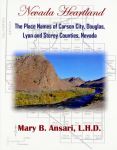 Nevada Heartland: The Place Names of Carson City, Douglas, Lyon and Storey Counties, Nevada
Nevada Heartland: The Place Names of Carson City, Douglas, Lyon and Storey Counties, Nevada
Author: Mary B. Ansari, L.H.D.
Year: 2015
Format: 301 pages, paperback
Publisher: LeRue Press, LLC
Order link: http://pubs.nbmg.unr.edu/Nevada-heartland-Ansari-p/lp01.htm
Do you know the answers? (from the back cover of this book):
- In what city was a major horse racing track, considered to be the fastest track in the Pacific Coast area, located?
- What place name in Syria is also a place name in Lyon County?
- What woman, in 1875, won a bid to erect an iron fence with gates around the Nevada State Capitol Building grounds?
- What did the customers call the liquor, made by a saloon owner in Yerington, in the early settlement days?
“No one writing today knows more about the geographic names of northwestern Nevada’s core historic section than Mary Ansari. Beginning in the mid-1980s, she published four volumes about the place names of Storey, Ormsby (now Carson City), Lyon, and Douglas counties, as well as a book about the names of mines and mills of the Comstock. These exhaustively researched publications provided the most complete information up to then about the names found on maps of those counties—their origins, meanings, and even data on important events or personalities associated with them.
Now, she has revised and expanded the material from her earlier books and brought it together in a new work that is the definitive place name reference for what is really the “heartland” of Nevada, the area where the state’s initial nineteenth century economic, political, and community development occurred.
Far from being a rote listing of similar facts about one site after another, Nevada Heartland is, in effect, a fascinating discussion about the landscape of an important region of our state. It is full of history, obviously, and much of that makes for quite entertaining reading. One can dip into the book at any point and find not only significant information about the name of a specific place, but also little-known facts or stories relating to the site.
We, and the many others who will read or consult it in the future, are fortunate to at last have in our hands this culmination of the author’s exceptional, decades-long work in the field of Nevada geographic names.” (from this book’s “Foreword” by Eric N. Moody, Nevada in the West magazine)
Dedication (by Mary Ansari):
In memory of my place-name mentor, Alvin R. McLane,
and as a 50th anniversary gift for my husband, Nazir A. Ansari
About the author (from back cover of book):
During the 25 years that Mary Ansari was a member of the University of Nevada, Reno faculty, she held a variety of administrative positions in the University Library. She was tenured in 1973 and promoted to professor in 1983. In 1994, she retired as Director Emerita of Administrative Services and Branch Libraries. During her tenure at the University, she published widely in library and place-name literature. She was national president of the Geoscience Information Society, and the society’s Distinguished Service and Best Reference Book awards bear her name.
With her husband, Nazir, she has been a major benefactor to education, human services, and the arts in Nevada. She is trustee and secretary-treasurer of the Nazir and Mary Ansari Foundation, a charitable foundation seeking to improve people’s lives through support of human services, education, the arts and culture in northern Nevada. In 2007, she and her husband were recognized by the University of Nevada’s Board of Regents as Distinguished Nevadans and were honored as Outstanding Philanthropists by the Sierra Chapter of the Association of Fundraising Professionals. The University of Nevada, Reno’s Map Library bears her name. She has served on several public boards and continues to publish books on Nevada place names.
Mary received a Masters degree in Library Science from the University of Illinois and a Masters in Business Administration from Western Michigan University. She received a Doctorate of Humane Letters from the University of Nevada, Reno. Mary and her husband reside in Incline Village, Nevada, USA.
Cover map: compiled by Jennifer Vlcan, Nevada Bureau of Mines and Geology

 Nevada Heartland: The Place Names of Carson City, Douglas, Lyon and Storey Counties, Nevada
Nevada Heartland: The Place Names of Carson City, Douglas, Lyon and Storey Counties, Nevada